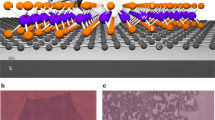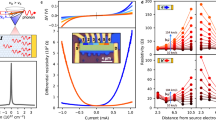Abstract
The cooling of hot electrons in graphene is the critical process underlying the operation of exciting new graphene-based optoelectronic and plasmonic devices, but the nature of this cooling is controversial. We extract the hot-electron cooling rate near the Fermi level by using graphene as a novel photothermal thermometer that measures the electron temperature (T(t)) as it cools dynamically. We find the photocurrent generated from graphene p–n junctions is well described by the energy dissipation rate CdT/dt = −A(T3−Tl3), where the heat capacity is C = α T and Tl is the base lattice temperature. These results are in disagreement with predictions of electron–phonon emission in a disorder-free graphene system, but in excellent quantitative agreement with recent predictions of a disorder-enhanced supercollision cooling mechanism. We find that the supercollision model provides a complete and unified picture of energy loss near the Fermi level over the wide range of electronic (15 to ∼ 3,000 K) and lattice (10–295 K) temperatures investigated.
This is a preview of subscription content, access via your institution
Access options
Subscribe to this journal
Receive 12 print issues and online access
$209.00 per year
only $17.42 per issue
Buy this article
- Purchase on Springer Link
- Instant access to full article PDF
Prices may be subject to local taxes which are calculated during checkout





Similar content being viewed by others
References
Viljas, J. K. & Heikkilä, T. T. Electron-phonon heat transfer in monolayer and bilayer graphene. Phys. Rev. B 81, 245404 (2010).
Tse, W-K. & Das Sarma, S. Energy relaxation of hot Dirac fermions in graphene. Phys. Rev. B 79, 235406 (2009).
Bistritzer, R. & MacDonald, A. H. Electronic cooling in graphene. Phys. Rev. Lett. 102, 206410 (2009).
Kubakaddi, S. S. Interaction of massless Dirac electrons with acoustic phonons in graphene at low temperatures. Phys. Rev. B 79, 075417 (2009).
Malic, E., Winzer, T., Bobkin, E. & Knorr, A. Microscopic theory of absorption and ultrafast many-particle kinetics in graphene. Phys. Rev. B 84, 205406 (2011).
Song, J. C. W., Reizer, M. Y. & Levitov, L. S. Supercollisions and the bottleneck for electron-lattice cooling in graphene. Phys. Rev. Lett. 109, 106602 (2012).
Sun, D. et al. Hot carrier cooling by acoustic phonons in epitaxial graphene by ultrafast pump–probe spectroscopy. Phys. Status Solidi C 8, 1194–1197 (2011).
Mueller, T., Xia, F. & Avouris, P. Graphene photodetectors for high-speed optical communications. Nature Photon. 4, 297–301 (2010).
Lemme, M. C. et al. Gate-activated photoresponse in a graphene pn junction. Nano Lett. 11, 4134–4137 (2011).
Bonaccorso, F., Sun, Z., Hasan, T. & Ferrari, A. C. Graphene photonics and optoelectronics. Nature Photon. 4, 611–622 (2010).
Yan, J. et al. Dual-gated bilayer graphene hot-electron bolometer. Nature Nanotech. (2012).
Fong, K. C. & Schwab, K. C. Ultrasensitive and wide-bandwidth thermal measurements of graphene at low temperatures. Phys. Rev. X 3, 031006 (2012).
Breusing, M., Ropers, C. & Elsaesser, T. Ultrafast carrier dynamics in graphite. Phys. Rev. Lett. 102, 086809 (2009).
Meric, I. et al. Current saturation in zero-bandgap, top-gated graphene field-effect transistors. Nature Nanotech. 3, 654–659 (2008).
Gabor, N. M. et al. Hot carrier assisted intrinsic photoresponse in graphene. Science 334, 648–652 (2011).
Song, J. C. W., Rudner, M. S., Marcus, C. M. & Levitov, L. S. Hot carrier transport and photocurrent response in graphene. Nano Lett. 11, 4688–4692 (2011).
Xu, X., Gabor, N. M., Alden, J. S., van der Zande, A. M. & McEuen, P. L. Photo-thermoelectric effect at a graphene interface junction. Nano Lett. 10, 562–566 (2009).
Sun, D. et al. Ultrafast hot-carrier-dominated photocurrent in graphene. Nature Nanotech. 7, 114–118 (2012).
Wang, H. et al. Ultrafast relaxation dynamics of hot optical phonons in graphene. Appl. Phys. Lett. 96, 081917 (2010).
Urich, A., Unterrainer, K. & Mueller, T. Intrinsic response time of graphene photodetectors. Nano Lett. 7, 2804 (2011).
Strait, J. H. et al. Very slow cooling dynamics of photoexcited carriers in graphene observed by optical-pump terahertz-probe spectroscopy. Nano Lett. 11, 4902–4906 (2011).
Winnerl, S. et al. Carrier relaxation in epitaxial graphene photoexcited near the dirac point. Phys. Rev. Lett. 107, 237401 (2011).
Li, X. et al. Large-area synthesis of high-quality and uniform graphene films on copper foils. Science 324, 1312–1314 (2009).
Acknowledgements
This research was supported by the Kavli Institute at Cornell for Nanoscale Science (KIC), AFOSR (FA 9550-10-1-0410), by the NSF through the Center for Nanoscale Systems and by the MARCO Focused Research Center on Materials, Structures, and Devices. We thank J. Song, K. McGill and J. Kevek for their helpful contributions. Device fabrication was performed at the Cornell Nanofabrication Facility/National Nanofabrication Infrastructure Network.
Author information
Authors and Affiliations
Contributions
The experiment was built by M.W.G. and measurements performed by M.W.G. and S-F.S. Graphene devices were fabricated by S-F.S. Theory and data analysis was performed by M.W.G. and P.L.M. All authors participated in the elaboration of the research project.
Corresponding authors
Ethics declarations
Competing interests
The authors declare no competing financial interests.
Supplementary information
Supplementary Information
Supplementary Information (PDF 1705 kb)
Rights and permissions
About this article
Cite this article
Graham, M., Shi, SF., Ralph, D. et al. Photocurrent measurements of supercollision cooling in graphene. Nature Phys 9, 103–108 (2013). https://doi.org/10.1038/nphys2493
Received:
Accepted:
Published:
Issue Date:
DOI: https://doi.org/10.1038/nphys2493
This article is cited by
-
Gate-controlled suppression of light-driven proton transport through graphene electrodes
Nature Communications (2023)
-
Photocurrent as a multiphysics diagnostic of quantum materials
Nature Reviews Physics (2023)
-
Observation of hydrodynamic plasmons and energy waves in graphene
Nature (2023)
-
Ultrafast intrinsic optical-to-electrical conversion dynamics in a graphene photodetector
Nature Photonics (2022)
-
Strongly enhanced THz generation enabled by a graphene hot-carrier fast lane
Nature Communications (2022)



